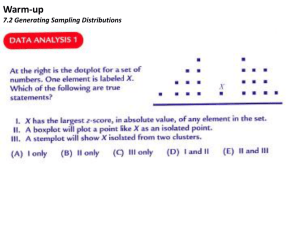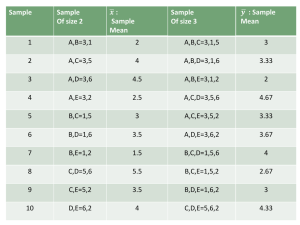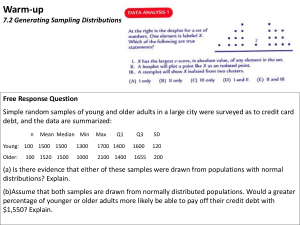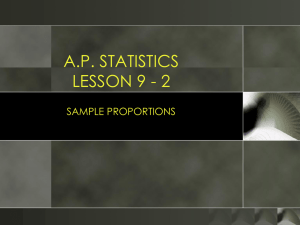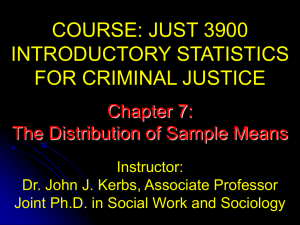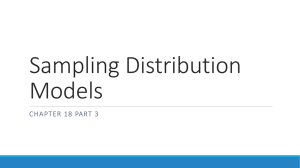36. SOLVING THE MEAN AND VARIANCE OF A SAMPLING
advertisement
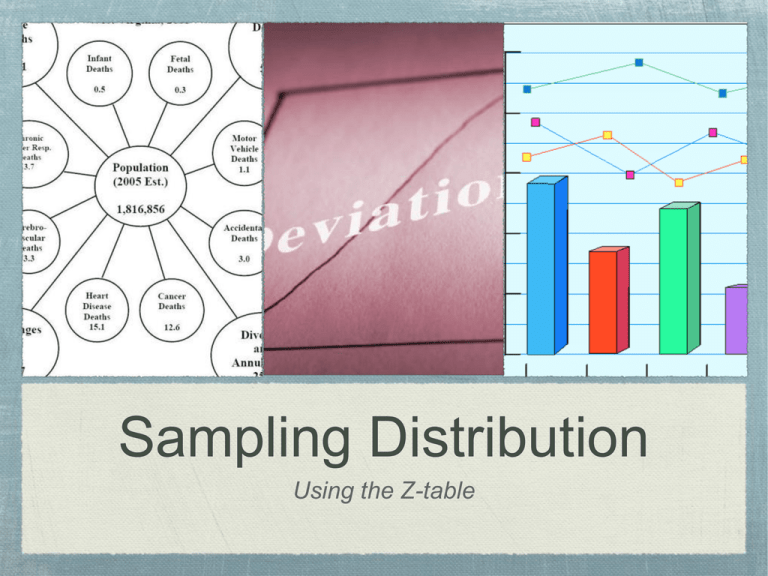
Sampling Distribution Using the Z-table Review: on using TI-84 Syntax: 2nd>vars>normalcdf>min,max,0,1) +infinity=1EE99 -infinity=-1EE99 1. z > 2.85 0.0022 2. z < 2.85 0.9978 3. z > -1.66 0.9515 4. -1.66< z <2.85 0.9493 Review: on using TI-84 Syntax: 2nd>vars>normalcdf>min,max,mean,sd) +infinity=1EE99 -infinity=-1EE99 1. x > 0.40, mean: 0.37, sd: 0.04 0.2266 2. 0.40<x< 0.50, mean: 0.37, sd: 0.04 0.2260 3. 0.40<x< 0.50, mean: 0.41, sd: 0.02 0.6915 Sampling distribution of sample proportion p = Count of success in sample Size of the sample = X n The mean of the sampling distributionp is exactly p The standard deviation of the sampling distribution p is p(1-p) n √ One way of checking the effect of under-coverage, non response, and other sources of error in a sample survey is to compare the sample with the known facts about the population. About 11% of American adults are black, the proportion of blacks in an SRS of 1500 adults should therefore be close to 0.11. It is unlikely to be exactly 0.11 because of sampling variability. If a national sample contains only 9.2% blacks should we suspect the sampling procedure is somehow under-representing blacks? ƥ=0.11 ℳ=0.11 σ=0.00808 σ= √ X=.092 p(1-p) n P(ƥ ≤ 0.092)= 0.0129 Only 1.29% of all samples would have so few blacks. Therefore we have a good reason to suspect that the sampling procedure underrepresented blacks. Rule of Thumb 1. You can only use the formula for the standard deviation of p-hat only when the population is at least 10 times as large as the sample N≧10n 2. Use the normal approximation to the sampling distribution of p-hat for values of n and p that satisfy np≧10 and n(1-p)≧10 Practice: Rule of thumb(s) Explain why you cannot use the methods in ch9.1 on this problem A factory employs 3000 unionized workers, of whom 30% are hispanic. The 15-member union executive committee contains 3 hispanics. What would be the probability of 3 or fewer Hispanics if the executive committee were chosen at random from all the worker. np≧10 and n(1-p)≧10 15(.30)≧10 and 15(1-30)≧10 4.5≧10 and 10.5≧10 Mean and Standard Deviation of a sample mean Mean of sampling distribution: ℳx = ℳ Standard Deviation of sampling distribution: σx = σ / √n Mean and Standard Deviation of a sample mean Investors remember 1987 as the year the stocks lost 20% of their value in a single day. For 1987 as a whole, the mean return of all common stocks on the NYSE was ℳ=3.75% and the standard deviation of the returns was about σ=26%. What are the mean and standard deviation of the distribution for all possible samples of 5 stocks? ℳ= -3.75% or -.00375 σx = σ / √n 26 / √5 σ= 11.6376% σ= Example: Servicing Air conditioners The average of servicing an air conditioning unit in a certain company is 1 hour with a standard deviation of 1 hour as well. The company has been contracted to maintain 70 of these units in an apartment building. You must schedule technicians’ time for a visit to this building. Is it safe to budget an average of 1.1 hours for each unit? Or should you budget 1.25 hours? ℳ=1, σ=1 Sd=σ/√n 1/√70=0.120hrs ℳ=1 hr. σ=.120 hr. P(x-bar>1.1 hrs.) normalcdf(1.1 , +∞ , 1, .120) = 0.2033 If you budget 1.1 hrs, there is a 20% chance that the technicians will not be able to complete the work N(1, .120) P(x-bar>1.25 hrs.) normalcdf(1.25 , +∞ , 1, .120) = 0.0182 If you budget 1.25 hrs, there is a 2% chance that the technicians will not be able to complete the work What you should have learned A. Sampling Distribution 1. Identify parameters and statistics in sample experiment. 2. Recognize the fact of sampling variability. 3. Interpreting sampling distribution. 4. Describe the bias and variability of statistic in terms of the mean and its spread. 5. Understand the variability of a statistic. Statistic from larger samples are less variable. B. Sample Proportions 1. Recognize when a problem involves a sample proportion ƥ 2. Find the mean and standard deviation of sampling distribution 3. Know that as the spread gets smaller the sample size gets bigger. 4. Recognize a reliable conclusion by verifying the rule of thumbs: N≥10n and np≥10, nq≥10 C. Sample Means 1. Recognize when a problem involves the mean of the sample. (x-bar) 2. Find the mean and sd of the sampling distribution when the ℳ and σ of the population are known. 3. Know that as the spread gets smaller the sample size gets bigger 4. X-bar is approximately Normal when the sample size is large (CLT)

